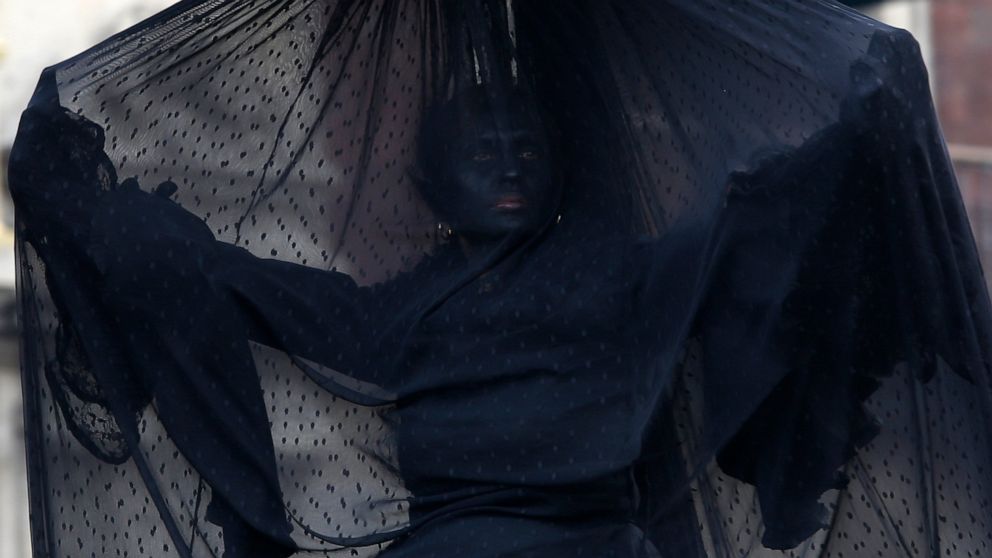Thousands of Mexicans took to the streets of the capital to dance beside giant skulls and skeletons Sunday as Mexico City rolled out its fourth edition of a Day of the Dead parade inspired by Hollywood, part of an ever-expanding menu of festivities for the holiday.
The city once again borrowed props from the opening scene of the 2015 James Bond film, “Spectre,” in which Daniel Craig’s title character dons a skull mask as he makes his way through a crowd of revelers. Festivities in the capital have expanded in recent years to capitalize on growing interest in the holiday, with temporary art installations in public spaces and colorful weekend events. Yet another elaborate parade is scheduled to traverse the city’s iconic Reforma boulevard on Nov. 2, All Souls Day.
All told, the party in the capital will stretch out over more than two weeks, versus a traditional celebration of just a few days.
Sunday’s show featured enormous, brightly painted puppets in shapes like the Xoloitzcuintli, a hairless dog venerated by pre-Hispanic societies, and dancers decked out like skeletons moving to the brass sounds of marching bands. The carnival-like atmosphere was a celebration of all things Mexican, in contrast to the somber Day of the Dead affairs many Mexican families have long hosted in the privacy of their homes or at cemeteries.
“Festivities make the country happy in Mexico and anywhere else,” said Cindy Saenz, the parade’s coordinator.
For Avelina Bautista, who arrived to the capital a few days earlier from southern Mexico to sell woven handicrafts with her family, the spectacle was completely foreign.
In her town in Oaxaca, where the indigenous population speaks a Mixtec dialect, Day of the Dead is a three-day celebration that begins with children going house-to-house to receive sweet pumpkin treats from neighbors. At night, the townspeople gather in the local cemetery to sit vigil at their loved ones’ graves, strewn with lit candles and orange marigolds. It’s a booze-filled event with live music that lasts until sunrise.
“We say the rosary, we sing, we cry and we start to analyze, to remember all of our loved ones,” she said.
Day of the Dead has religious roots: before the Spanish conquest, the Aztecs dedicated most of August to their goddess of death, Mictecacihuatl. Some indigenous communities believed they could contact their departed family at altars or caves. As part of the Spanish repression of indigenous beliefs, the celebration was moved to coincide with Catholic holidays like All Saints’ Day.
Mexican families who honor the tradition construct altars to their ancestors this time of year. They’ll typically light candles and place flowers next to their ancestors’ pictures, alongside an offering of their loved ones’ favorite foods.
Hollywood adaptations of Day of the Dead festivities in movies such as Disney’s Coco (2017) have drawn international attention to the holiday, which had fallen into decline in recent decades in Mexico.
The Hollywood attention has also brought greater commercialization, with products ranging from Day of the Dead Barbie dolls to sneakers, and celebrations sprouting up among non-Mexicans in places like the U.S.
“The commercial element doesn’t mean the sacred element disappears,” said R. Andrew Chesnut, a professor of Religious Studies at Virginia Commonwealth University who researches Catholic death culture.
Patricia Arroyo, an Otomí community artisan from central Mexico who was selling clay skulls along the parade route Sunday, looked at the crowd and concluded that Mexico City’s Day of the Dead events seem more like a parody of the tradition.
“It should be more natural,” Arroyo said.
She herself has only once built an altar, to her deceased mother, having left all Catholic traditions when she became an evangelical Christian years ago. Other members of her indigenous community make an annual trek to their town cemetery in the state of Queretaro.
For many Mexicans embracing the parades and increasingly public celebrations, though, Day of the Dead is as good an excuse as any to party.
That’s the way Mayra Martínez, a mother and dentist, sees it. “The trick is to celebrate,” she said, wearing a dress covered in skulls and her face painted like a skull, too. “This is a good pretext.”
